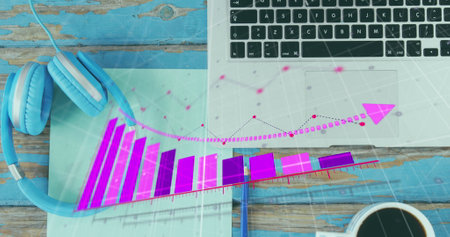1. Understanding Data Analytics for Airbnb Rentals
If you’re an Airbnb host aiming to thrive in emerging markets, understanding data analytics isn’t just helpful—it’s essential. In today’s digital-first world, data analytics acts as your GPS, guiding decisions that can boost occupancy rates, optimize pricing, and elevate guest satisfaction. By leveraging analytics tools, hosts gain access to a treasure trove of actionable insights: from seasonal demand patterns to competitor benchmarking and guest demographics. Think of data analytics as your backstage pass to market trends, allowing you to see beyond gut feelings or outdated intuition.
For hosts in the U.S., where competition is fierce and traveler expectations are always evolving, using data-driven strategies separates thriving businesses from those left behind. It’s not just about crunching numbers—it’s about storytelling with data. You’ll uncover the ‘why’ behind booking trends and learn to spot opportunities before your competitors do. Whether you’re new to Airbnb or scaling your portfolio across growing neighborhoods, mastering analytics empowers you to make smarter decisions, personalize guest experiences, and ultimately maximize your rental performance in fast-changing markets.
2. Key Metrics That Drive Success
When it comes to predicting Airbnb rental performance in emerging markets, data analytics is only as good as the metrics you track. Identifying the most critical data points gives you a strategic edge—helping you move beyond gut instinct to make informed decisions that truly resonate with local dynamics and guest preferences.
Essential Metrics for Airbnb Success
The following are foundational metrics every host or investor should monitor:
| Metric | Description | Why It Matters in Emerging Markets |
|---|---|---|
| Occupancy Rate | The percentage of days your property is booked within a specific period. | Indicates demand trends, seasonality, and how well your listing competes locally. |
| Average Daily Rate (ADR) | The average revenue earned per booked night. | Shows pricing power and helps benchmark against local competitors. |
| Revenue per Available Room (RevPAR) | Total revenue divided by available nights. | Merges occupancy and ADR insights to reveal true earning potential. |
| Guest Reviews & Ratings | Feedback scores and written reviews from guests. | Impact search ranking, trust, and booking conversion rates—especially crucial where brand awareness is low. |
| Booking Lead Time | The average time between reservation and check-in. | Affects dynamic pricing strategies and helps anticipate demand surges or slowdowns. |
| Cancellation Rate | The proportion of bookings that are canceled before check-in. | Helps identify risk factors unique to emerging markets, such as payment issues or travel instability. |
Diving Deeper: What Sets Emerging Markets Apart?
Emerging markets often experience rapid shifts in supply and demand, evolving guest expectations, and fluctuating local regulations. In these settings, even small changes in occupancy or ADR can dramatically impact profitability. Guest reviews carry extra weight as travelers lean heavily on trust signals when booking in less familiar destinations. Meanwhile, monitoring booking lead time and cancellation rates lets you adapt quickly to market volatility and optimize your calendar for high-demand periods or special events unique to your area.
Pro Tip: Local Context Matters
No single metric tells the full story. Successful hosts layer these data points—comparing them month-over-month and year-over-year—to spot trends, uncover new opportunities, and minimize risks. Always benchmark your numbers against similar listings in your city or neighborhood to set realistic targets and fine-tune your strategy for the nuances of emerging markets.

3. Sourcing and Integrating Local Market Data
To accurately predict Airbnb rental performance in emerging markets, the foundation is robust, localized data. Start by identifying neighborhood comparables—these are properties similar to your listing in size, amenities, and location. Analyze their occupancy rates, nightly pricing, and seasonal trends through platforms like AirDNA or Mashvisor. Go beyond just property data: tap into local tourism boards or municipal reports to track visitor volume spikes, event calendars, and any regulatory changes that could impact short-term rentals.
Neighborhood Comparables: Your Benchmark
Comparables (or “comps”) provide a lens into what guests are willing to pay and expect in your target area. Scrape data on active listings to spot patterns in booking frequency, guest reviews, and minimum stay requirements. The closer the comp’s characteristics match your own property, the sharper your pricing and performance predictions will be.
Tapping into Tourism Trends
Emerging markets are often driven by unique travel patterns—think new airline routes or trending cultural festivals. Use state tourism databases or Google Trends to monitor visitor surges. By correlating these trends with booking upticks on Airbnb, you can better anticipate high-demand periods and adjust your strategy accordingly.
Assessing the Competition
Don’t overlook the power of competitive analysis. Explore how top-performing listings in your niche present themselves—study their photos, descriptions, and guest interaction styles. Tools like PriceLabs can automate tracking of competitor pricing so you’re never caught off guard by sudden market shifts.
Integrating Data for Actionable Insights
The real edge comes from blending these diverse data sources together. Create dashboards that overlay comps, tourism stats, and competitor moves. This holistic view lets you forecast demand spikes or lulls before they hit the mainstream rental market. In America’s dynamic rental scene, those who master local data integration gain a decisive advantage—and consistently outperform the average host.
Predictive Models and Tools for Rental Forecasting
If you’re aiming to get ahead in Airbnb’s emerging markets, mastering predictive models and analytics tools isn’t just a nice-to-have—it’s essential. Modern hosts and property managers increasingly rely on data-driven insights to estimate future demand, optimize pricing, and stay competitive. Let’s break down the most effective models and the best tools that can help forecast rental performance with confidence.
Popular Analytics Tools for Airbnb Data
The right toolkit can make all the difference when analyzing rental trends. Here are some go-to platforms widely used in the U.S. market:
| Tool | Best For | Features |
|---|---|---|
| AirDNA | Market benchmarking, occupancy rates, revenue forecasting | User-friendly dashboards, competitive set analysis, historical & projected data |
| PriceLabs | Pacing and dynamic pricing strategies | Automated pricing suggestions, demand forecasting |
| Tableau/Power BI | Custom visualizations and dashboard creation | Drag-and-drop analytics, integration with multiple data sources |
| Google Colab (Python/R) | Custom model development, advanced analytics | Coding flexibility, machine learning libraries (scikit-learn, TensorFlow) |
Regression Models: The Backbone of Forecasting
Linear regression models are a classic choice for predicting rental income based on variables like seasonality, local events, number of reviews, or proximity to attractions. These models help answer key questions such as: How much will occupancy increase if I drop nightly rates by 10%? Or, what’s the expected revenue if I add a second bedroom?
Common Variables Used in Regression Analysis:
- Nightly rate
- Seasonality (month/quarter)
- Guest review scores
- Listing amenities (WiFi, kitchen, pool)
- Local event calendars
- Lead time (days between booking and stay)
Diving into Machine Learning Basics
If you want to take your predictions up a notch, machine learning can reveal hidden patterns in your Airbnb data. Basic models like decision trees, random forests, or K-nearest neighbors (KNN) are accessible ways to predict price optimization or expected bookings—even without being a data scientist. Many platforms now offer drag-and-drop workflows so you can experiment with these algorithms hands-on.
Steps to Build Your Own Predictive Model:
- Select relevant features: Focus on the factors that most impact rental performance in your market.
- Split your dataset: Use one part for training your model and another for testing accuracy.
- Tune parameters: Adjust your model settings to maximize predictive power.
- Interpret results: Translate output into actionable strategies—like adjusting minimum night stays or launching off-season promotions.
The bottom line? By blending user-friendly tools with foundational regression and machine learning models, you’ll transform raw Airbnb data into sharp forecasts—and unlock new profit potential in any emerging rental market.
5. Turning Insights into Smart Hosting Strategies
Once you’ve gathered and analyzed your Airbnb data, the real magic happens when you translate those insights into actionable strategies. Especially in emerging markets, a data-driven approach can help you stay ahead of the curve, maximize revenue, and build an unbeatable guest experience.
Refining Your Pricing with Precision
Dynamic pricing isn’t just a buzzword—it’s a game-changer for Airbnb hosts. By leveraging predictive analytics, you can identify seasonal trends, local events, and demand spikes to adjust your nightly rates in real time. This means setting competitive prices during high-demand periods and offering attractive deals during slower months, ensuring your listing remains appealing without leaving money on the table.
Pro Tip: Use Automated Tools
Incorporate smart pricing tools like Beyond or PriceLabs that sync with your Airbnb calendar. These platforms use machine learning to analyze competitors and market shifts, helping you optimize your earnings effortlessly.
Enhancing Guest Experience Through Data
Data doesn’t just help with numbers—it can also elevate your hospitality game. Analyzing guest reviews and feedback reveals what travelers value most in your area. Maybe guests are craving faster Wi-Fi, or they consistently mention loving your self-check-in feature. Use these insights to refine amenities and personalize touches that resonate with future guests.
Implement Personalization at Scale
Consider segmenting guests based on booking habits—business travelers vs. families vs. digital nomads—and tailor communication or amenities accordingly. For example, providing workspace essentials for remote workers or family-friendly guides for parents can boost satisfaction and lead to glowing reviews.
Boosting Occupancy in New Markets
Emerging markets often have untapped potential—but they also come with less predictable demand patterns. Monitor metrics like occupancy rates, average length of stay, and booking lead times to spot trends early. If bookings dip midweek, consider special discounts or partnerships with local businesses to attract weekday travelers.
Stay Agile and Experiment
The key is adaptability. Regularly test new strategies—such as weekend packages or extended-stay discounts—and track their performance using your analytics dashboard. Let the data guide your decisions so you’re always ahead in capturing new opportunities.
Summary
By putting insights into action—refining pricing, elevating the guest experience, and proactively managing occupancy—you transform raw data into a powerful roadmap for success in any emerging Airbnb market.
6. Navigating Risks Unique to Emerging Markets
Emerging markets offer exciting opportunities for Airbnb investors, but they also come with a unique set of risks that can challenge even the most seasoned hosts. Leveraging data analytics is essential to identifying, assessing, and mitigating these uncertainties in a way that’s both proactive and strategic.
Spotting Red Flags Early
The first step is knowing what to look for. Use real-time data streams—like local news sentiment analysis, changes in booking patterns, or regional economic indicators—to flag early warning signs. For example, sudden drops in booking rates or abnormal fluctuations in nightly prices can signal underlying issues such as political instability or negative regulatory shifts.
Assessing the Severity of Risks
Not all risks are created equal. Data analytics helps you quantify potential threats by modeling scenarios based on historical data and predictive trends. If a region has experienced frequent regulatory changes, you can use machine learning algorithms to estimate the likelihood and impact of future policy adjustments on your rental’s occupancy and revenue.
Mitigating Uncertainty with Smart Decisions
Once you’ve identified and assessed the risks, it’s time to act. Adaptive pricing tools allow you to adjust rates dynamically in response to market volatility. Location intelligence platforms can recommend safer investment neighborhoods by correlating factors like crime rates, infrastructure projects, and tourism demand. Additionally, monitoring competitor strategies using web scraping tools helps you stay agile when local conditions shift unexpectedly.
In summary, turning data into actionable insights empowers Airbnb hosts to navigate emerging market challenges with confidence. By continuously monitoring key indicators and building flexible risk response strategies, you ensure your rental business not only survives but thrives amid uncertainty.
7. Success Stories from American Hosts Abroad
Be inspired by real-life case studies featuring U.S.-based Airbnb entrepreneurs leveraging analytics to outperform in up-and-coming markets. These stories showcase how American hosts are using data-driven strategies not just to survive, but to thrive in new and unfamiliar territories.
The Texan Who Conquered Bogotá
Meet Lisa, a former Dallas-based digital marketer who set her sights on Bogotá, Colombia. By utilizing Airbnb’s performance dashboards and third-party tools like AirDNA, she tracked seasonal trends, local demand spikes, and competitive pricing. Her secret? Segmenting her audience by traveler type—business vs. leisure—and tailoring amenities and communication accordingly. Within one year, her occupancy rate jumped 25% above the city average.
Data Points That Made a Difference
- Occupancy heatmaps revealed untapped mid-week business travel potential.
- Sentiment analysis of reviews uncovered unmet needs around high-speed Wi-Fi.
Miami Innovators in Tbilisi
Brothers Matt and Chris from Miami saw opportunity in Georgia’s capital, Tbilisi. Using predictive analytics, they forecasted surges tied to festivals and international conferences. Dynamic pricing algorithms allowed them to adjust rates daily, ensuring maximum revenue during high-demand windows.
How Analytics Led the Way
- Event calendars merged with booking data revealed ideal times for premium pricing.
- Competitor benchmarking clarified gaps in the local short-term rental landscape.
The California Host Who Elevated Experiences in Vietnam
Samantha, hailing from San Francisco, moved to Da Nang and analyzed guest feedback across multiple platforms. She identified that family travelers were underserved. By optimizing her listing for extended stays and adding kid-friendly amenities based on keyword frequency analysis, she doubled her bookings within six months.
Key Takeaway
Each of these American hosts succeeded by treating Airbnb rentals as a business rooted in local data—not guesswork or stereotypes. Their stories prove that harnessing analytics is not just a trend; it’s the foundation for outperforming competitors in emerging markets worldwide.

